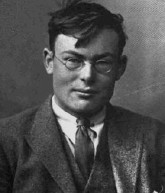

Frank Ramsey's father was President of Magdalene College in Cambridge, and a tutor in mathematics there. His only brother went on to become Archbishop of Canterbury.
Ramsey completed his secondary education at Winchester College in 1920, and won a scholarship to Trinity College in Cambridge, where he studied mathematics and graduated in 1923. After graduating, he was elected a fellow of King's College in Cambridge in 1924. He was only the second person ever to be elected to a fellowship at King's College who had not previously studied at King's.
He was a quiet man, easy going and uninhibited. He was a militant atheist, but his tolerance and good humor enabled him to disagree strongly without giving or taking offense. He was 6'3" tall, bulky, and short-sighted. He only wrote in the mornings, preferring tennis, walking, or classical music in the evenings.
He began as a lecturer in mathematics, but soon became Director of Studies in Mathematics. Unfortunately, Ramsey died a few years later of jaundice at the age of 26.
He published his first major mathematics paper, The Foundations of Mathematics, in 1925. His second and last mathematics paper, On a problem of formal logic, was published in 1930, and examined methods for determining the consistency of a logical formula. But it also included some theorems on combinatorics which have led to the study of a whole new area of mathematics called Ramsey theory. This paper has stimulated an enormous study in both graph theory and in other branches of mathematics.
Although Ramsey was a lecturer in mathematics, he also wrote on the foundations of mathematics, economics, and philosophy. Ramsey was a close friend of John Maynard Keynes, the famous economist. In economics, Ramsey wrote two papers A contribution to the theory of taxation and A mathematical theory of saving. These would lead to important new areas in the subject. It was philosophy, however, that was Ramsey's real love.